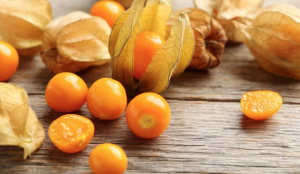Gooseberry farming is Kenya is yet to pick up hence it is categorized as one of the underutilized fruit.
However due to its nutritional value the crop is steadily picking up. It is one of the 100 crops earmarked to commercialization by the government in the Big 4 Agenda. It grows wild in some areas including in the Rift Valley, Coastal region, Western region and Mount Kenya region. The fruit is rich in vitamin A, B,C, nutrients, antioxidants, fiber and Iron. In addition, it is low in calories and is good for the heart. It grows from seed and takes between 14 to 16 weeks from planting to harvest. A gooseberry tree can yield an average of 200 fruits per season with two flowering seasons. An acre can hold approximately 2500 plants.
The Benefits of Gooseberry Farming
Farmers may gain from gooseberry farming, which is additionally referred to as amla farming. Here are a few of the primary advantages:
Gooseberries have a high nutritional value because they contain high in essential vitamins and minerals like vitamin C, vitamin A, iron, calcium, and antioxidant. Farmers can assist develop healthy eating habits by offering healthy meals to consumers by growing gooseberries.
Gooseberries are well-known for their medicinal properties in traditional and Ayurvedic medicines. They have been shown to have an array of health benefits, including immune system stimulation, digestive enhancement, hair and skin maintenance, and anti-inflammatory abilities. This offers farmers with new opportunity for capitalizing on the growing need for natural and herbal therapies.
Drought Tolerance: Gooseberries are tough plants that can survive dry circumstances, making them suitable for cultivation in places where water is scarce. This drought resistance helps farmers with minimizing their water consumption and risks associated with shortages of water.
Gooseberries have a fairly long lifespan, both while on the plant and once plucked. Farmers enjoy this characteristic because it allows them to preserve harvested fruit for a greater amount of time, enabling them to enhance distribution, promotion, and sales.
Gooseberries offer an extensive variety of uses. They can be eaten raw, incorporated into food preparations such jams, jellies, sauces, and desserts, or prepared into juice or extracts for commercial use. This flexibility gives farmers a number of income streams and market possibilities.
Gooseberry plants are usually low-maintenance crops that need minimal nurturing and care once planted. They are also fairly disease and pest resilient, reducing the need for heavy pesticide treatment and reduces farmers’ cost of production.
Market Demand: Given a greater focus on well-being and health, consumers have an increasing need for nutritious foods and natural cures. Gooseberries have been gaining popularity amongst customers because of their nutritional value and therapeutic characteristics. This creates a good prospective market for farmers who farm gooseberries.
Sustainable Farming: Organic and environmentally friendly farming methods can be utilized in gooseberry farming. Farmers assist in preserving the environment, protect biodiversity, and meet the growing need for organic produce through avoiding synthetic chemicals and pesticides.
Gooseberry plants are typically low-maintenance crops that require little tending and care once established. They are also relatively disease and insect resistant, which decreases the need for heavy pesticide treatment and lowers farmers’ production costs.
Market Demand: As consumers place more importance on their own well-being and health, there’s a growing demand for healthy meals and alternative therapies. Gooseberries are growing more popular amongst customers due to their nutritious content and medicinal benefits. This creates an exciting market for farmers who grow gooseberries.
Organic and sustainable farming methods can be used in gooseberry farming. By eradicating synthetic fertilizers and pesticides, farmers are helping save the environment, protect biodiversity, and meet the increasing need for organic produce.

Gooseberry Delight Ltd, a company that started 3 years ago and based in Kenya, Eldoret is mobilizing farmers in Uasin Gishu to practice Gooseberry farming for local and international market. It has come up with products for value addition including Yogurt, jam, juice and sauce. Other products that can be processed from the fruit include wine and jellies. It can also be eaten raw or dried.

According to the founder, Viola Maina, recruiting and convincing farmers to adapt to gooseberry farming has been a challenge. Farmers don’t see it as a high value product, as it is viewed as a wild fruit, a perception that needs to change. Lack of knowledge and research on the product is also a hindrance to production of gooseberry. In addition, the market for the fruit is not well established.
On the value addition front, capital, technical know how, quality, quantity and consistency are some of the challenges the company is facing.

In other words, there is a lot of opportunity in gooseberry farming and its value chain. This video highlights her journey in starting her gooseberry business, challenges, tips and opportunities in gooseberry value chain.
Also read more about 63 Best potato varieties in Kenya 2022 here.
